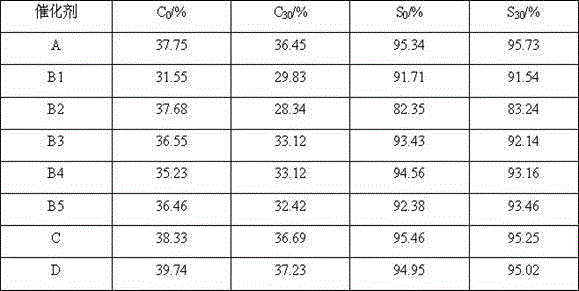Method for preparing low-carbon alkane dehydrogenation catalyst
A technology of dehydrogenation catalyst and low-carbon alkanes, which is applied in the direction of hydrocarbons, hydrocarbons, molecular sieve catalysts, etc., and can solve the problems of no industrialization examples of aerobic dehydrogenation technology
- Summary
- Abstract
- Description
- Claims
- Application Information
AI Technical Summary
Problems solved by technology
Method used
Image
Examples
Embodiment 1
[0036] Preparation of the carrier: Select 200g of ZSM-5 molecular sieve with a relative crystallinity of 50% and a silicon-aluminum ratio of 100, mix it with 350g of alumina, 25g of turnip powder and 50g of dilute nitric acid solution with a mass concentration of 10%, knead and extrude forming. The molded carrier was dried in the shade for 24 hours, then dried in an oven at 110° C. for 12 hours, and then baked in a muffle furnace at 600° C. for 6 hours. After cooling, the broken growth length is 2~5mm, and 50ml of the carrier is measured, impregnated with Sn, the catalyst-promoting component, and tin tetrachloride is selected as the precursor, and the Sn-containing carrier is obtained by drying and roasting. It was placed in a rotary evaporator and vacuumed for 30 min.
[0037] Preparation of impregnation solution: appropriate amount of ZnCl 2 Dissolve in 20ml of deionized water, and dropwise add 6ml of ammonia water with a mass concentration of 25% to it, and stir thoroughl...
Embodiment 2
[0053] Preparation of the carrier: Select 200g of ZSM-5 molecular sieve with a relative crystallinity of 70% and a silicon-aluminum ratio of 100, mix it with 400g of alumina, 25g of turnip powder and 50g of dilute nitric acid solution with a mass concentration of 10%, knead and extrude forming. The formed carrier was dried in the shade for 24 hours, then dried in an oven at 110°C for 10 hours, and then baked in a muffle furnace at 600°C for 7 hours. After cooling, the broken growth length is 2~5mm, and 50ml of the carrier is measured, impregnated with Sn, the catalyst-promoting component, and tin tetrachloride is selected as the precursor, and the Sn-containing carrier is obtained by drying and roasting. It was placed in a rotary evaporator and vacuumed for 30 min.
[0054] Preparation of impregnation solution: appropriate amount of ZnCl 2 Dissolve in 20ml of deionized water, and dropwise add 31ml of ammonia water with a mass concentration of 15% to it, and stir thoroughly a...
Embodiment 3
[0057] Preparation of the carrier: Select 200g of ZSM-5 molecular sieve with a relative crystallinity of 60% and a silicon-aluminum ratio of 150, mix it with 350g of alumina, 25g of turnip powder and 50g of dilute nitric acid solution with a mass concentration of 10%, knead and extrude forming. The formed carrier was dried in the shade for 24 hours, then dried in an oven at 110°C for 10 hours, and then baked in a muffle furnace at 600°C for 7 hours. After cooling, the broken growth length is 2~5mm, and 50ml of the carrier is measured, impregnated with Sn, the catalyst-promoting component, and tin tetrachloride is selected as the precursor, and the Sn-containing carrier is obtained by drying and roasting. It was placed in a rotary evaporator and vacuumed for 60 min.
[0058] Preparation of impregnation solution: appropriate amount of ZnCl 2Dissolve in 25ml of deionized water, and dropwise add 28ml of ammonia water with a mass concentration of 20% to it, and stir thoroughly af...
PUM
 Login to View More
Login to View More Abstract
Description
Claims
Application Information
 Login to View More
Login to View More - R&D
- Intellectual Property
- Life Sciences
- Materials
- Tech Scout
- Unparalleled Data Quality
- Higher Quality Content
- 60% Fewer Hallucinations
Browse by: Latest US Patents, China's latest patents, Technical Efficacy Thesaurus, Application Domain, Technology Topic, Popular Technical Reports.
© 2025 PatSnap. All rights reserved.Legal|Privacy policy|Modern Slavery Act Transparency Statement|Sitemap|About US| Contact US: help@patsnap.com

